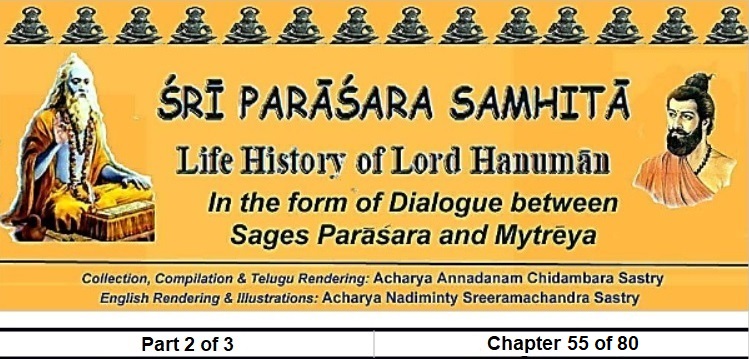
55th Chapter (Pancapancāśat Paţalah)
“Attributes of the String of Prayer Beads”
(Japamālā Lakşaņam)
श्रीपराशरः
वक्ष्यामि जपमालाया लक्षणं मुनिसत्तम
मालिकाबीजसंख्याया नियमं च विशेषतः।। 1
Śrī Paraāśara:
“Oh! Great sage Mytreya! I am especially telling the attributes of japamālā (String of Prayer Beads; rosary) and the number of beads in the string. (1)
नियता नियता चेति द्विविधा मालिका स्मृता
नियता मूलमन्त्राय सदा त्वनियता भवेत्।। 2
Types & Uses of Prayer Beads
The string is said to be of two types, namely, niyata (limited or destined) and aniyata (unlimited or undestined). The niyata string is accepted for reciting moola (basic or root) mantra. For all other purposes the aniyata string is accepted. (2)
मूलमन्त्रजपाद्यर्थां मालिकां न प्रदर्शयेत्
जपन्नपि सदा योगी गोमुखेनैव संजपेत्।। 3
The niyata string used for reciting the basic/root mantra should not be shown to others. It should be held in a small cloth bag (gōmukha vidhāna) while using. (3)
तेन मन्त्राः प्रसीदन्ति जपमालानिगूहनात्।।
सदा जपोचिता माला दर्शनादेव दुष्यति।। 4
Due to reciting the mantra in secret in the above manner, mantras will give the desired achievement of the soul and become benevolent. This niyata string becomes inauspicious if others see it. (4)
रुद्राक्षैः कमलाक्षैर्वा स्फाटिकैर्वापि विद्रुमैः
मुक्ताभिस्तुलसीकाष्ठैः कुर्याद्वै जपमालिकाम्।। 5
They prayer strings (rosary) have to be made of rudrākşa (= Tears of Śiva; seed within the blue berries, Elaeocarpus ganitrus, found in the Himalayan region), with seeds of lotus seeds, with quartz crystals, red coral stones, pearls or beads made out of holy basil (tulasi) wood. (5)
स्फाटिका मोक्षमित्याहुः मुक्ता कीर्तिकराः स्मृता
रुद्राक्षाः कमलाक्षाश्च सर्वसिद्धिप्रदायिनः।। 6
It is said that one gets liberation (mōkşa) from the mundane life (spiritually) if recites using a quartz crystal rosary. Recital using a pearl rosary makes one famous. All types of attainment (siddhi) can be obtained by using rosaries made of rudrākşa and lotus wood beads. (6)
विदु्रमै रचिता माला ह्यायुर्वृदिकरा भवेत्
चित्तशुद्धिप्रदा नृणां तुलसीकाष्ठमालिका।। 7
Rosary made of red coral beads gives longevity to humans, while that made of holy basil wood gives purification of mind (chittasuddhi). (7)
अष्टाविंशत्युत्तरेण शतेन जपमालिका
द्वाविशत्संख्यया वापि सप्तविंशतिसंख्यया।। 8
The prayer rosary has to be got made with 128 beads. One can get a rosary made with 32 or 27 beads. (8)
जपस्य सिद्धये सद्यः कुर्याद्वादशसंख्यया
सर्वत्र द्वादशी संख्या संख्यानामुत्तमोत्तमा।। 9
One has to use a 12 bead rosary for immediate success of the recital. Number 12 is the best amongst all the numbers. (9)
पठेद्द्वादशनामानि मालयादित्यसंख्यया
स्वाभीष्टसिद्धये योगी तथा सप्ताक्षरीमपि
षोडशाक्षरमन्त्रं वा हनुमत्प्रीतये सदा।। 10
A yogi has to recite using the 12 names of the Sun god. Similarly, for the endearment of Hanumān, one has to recite the seven-lettered (saptākşrī) or six-lettered (şadākşrī) mantra”. (10)
श्रीमैत्रये:
संत्यनन्तानि नामानि भगवन् हनुमत्प्रभोः
मन्त्राश्च बहवस्तस्य सर्वसिद्धिप्रदा नृणाम्।। 11
Śrī Mytrēya:
“Oh! Great soul! Seer Parāśra! Endless are the names and mantras of Hanumān that provide all achievements to humans. (11)
कानि द्वादश नामानि का वा स्यात् षोडशाक्षरी
का वा सप्ताक्षरी विद्या तन्ममाचक्ष्व तत्त्वतः।। 12
Which of those are among the 12 names told above? Which is the 16-lettered mantra? Which is the famous 7-lettered mantra? Tell me about all those in detail.” (12)
श्रीपराशरः
हनूमानंजनीसूनुः वायुपुत्रो महाबलः
रामेष्टः फाल्गुनसखः पिंगाक्षो मितविक्रमः।। 13
Śrī Paraāśara:
The 12 names of Hanumān
“The 12 names of Hanumān are – Hanumanta (One with dented jaw), Ańjaneesoona (Son of Ańjana), Vāyuputra (Son of Wind God), Mahābala (One mightily powerful), Rāmēşţa (One dear to Rāma), Phalguņasakha (Friend of Arjuna), Pingākşa (Red eyed), Amitavikrama (Strong and victorious unlimited), (13)
उदधिक्रमणश्चैव सीताशोकविनाशकृत
लक्ष्मणप्राणदाता च दशग्रीवस्य दर्पहा || 14
Udadhikramaņa (One who crossed the ocean), Sītāśōka vināśaka (One that removed the grief of Sītā), Lakşmaņa prāņadāta (One who revived dying Lakşmaņa) and Daśsgreevadarpaghna (One who dented the pride of Rāvaņa). These are to be recited rotating a rosary. (14)
इति द्वादश नामानि जप्यानि जपमालया
श्रीशब्दो हनुमच्छब्दो जयशब्दस्ततः परम्
जयद्वयादथ चोध्र्वं हनुमन्नामतत्त्वतः।। 15
The 16-lettred (şōdaśākşarī) mantra
Starting with the word ‘Śrī’, say the words ‘Hanuman’, ‘jaya’, ‘Hanuman’, then ‘jaya jaya’ twice and ‘Hanuman’. (15)
षोडशाक्षरमन्त्रो यं जप्तव्यो निजमालया
साधारणजपे मा स्तु न्यासध्यानाश्च मुद्रिकाः।। 16
This is the 16-lettred (şōdaśākşarī) mantra. One has to recite the six words of this using a prayer rosary. Only simple recital, but no nyāsa (body touchings), dhyāna (meditation) or mudrikas are needed. (16)
आदौ श्रीशब्दमुच्चार्य ततो हनुमते पदम्
नमश्शब्दं तदुच्चार्य अयं सप्ताक्षरी मनुः
एवं सप्ताक्षरीं विद्धि या जप्या जपमालया।। 17
The Saptākşarī mantra
Uttering first the letter ‘Śrī’, then saying ‘Hanumatē’ and then utter the word ‘namah’. This is the Saptākşarī mantra. Know this as 7-lettered mantra to be recited with the help of a rosary. (NOTE: This is not seen in some versions). (17)
अन्यं विशेषं वक्ष्यामि मैत्रेय! मुनिसत्तम!
यस्य श्रवणमात्रेण जपसिद्धिर्भवेन्नृणाम्।। 18
Rudrşamālikā Mantra
Oh! Best amonst sages! Mytrēya! I am telling another uniqueness that gives fruit of the recital (japasiddhi) by just listening it. (18)
ब्रह्मक्षत्रियविट्छूद्रचातुर्वण्र्यमुदाहृतम्
ब्राह्मणैर्जपसिध्यर्थं सर्वा धार्या हि मालिकाः।। 19
It was told that there are four types (profession wise) of people – brāhmins (priest class), kşatriyas (warrior class), vaiśyas (trading class) and sūdras (working class). All types of rosary strings can be used by Brahmins to attain fruits of recital. It was said rudrākşa string is better for brāhmins (yōgyārudrākşamālikā), however. (19)
क्षत्रियस्य विशेषेण जप्या पद्माक्षमालिका
अथवा मौक्तिकी माला सर्वसिद्धिप्रदायिनी।। 20
Recitation using a string made of lotus wood beads is good for the kştriyas; while used of a string of pearls is good for all spiritual attainments. (20)
विद्रु्रमैर्हेमबीजैश्च ग्रथिता जपमालिका
मन्त्रसिद्धिकरी सद्यः वैश्यानां मन्त्रवेदिनाम्।। 21
For mantra-profficient vaiśyas, recitation with the help of a string made of red coral or golden beads gives attainment of the mantra. (21)
शूद्राणां नाधिकारो स्ति मंत्रे वा जपकर्मणि
किन्तु ब्राह्मणसेवैव निरपायगतिप्रदा।। 22
No conditions were imposed for sūdras, with mantras and recitations. Just serving a teacher-like (gurutulya) person, with auspicious disposition and knowledge of Brahman (Supreme God) gives them good spiritual progress (sadgati) that is free from hindrances. (22)
अपरो यं विशेषो स्ति मैत्रेय शृणु तत्त्वतः
श्रद्धाहीनाय सो वाच्यो गोपनीयः सदा त्वया।। 23
Secret Mantra
Oh! Mytreya! There is another speciality. Listen with attention. It should never be told to an uninterested person. This has always to be kept secretive. (23)
मूलमन्त्रजपांते तु प्रत्यहं मन्त्रवित्तमः
ताम्रपात्रे जलं न्यस्य विधाय करसंपुटम्।। 24
One Free from the Cycle of Life and Birth (mantravid) or so desirous, keeping water in a copper vessel, putting hands in samputa mudra hand posture (sign of one’s inner treasure), (24)
द्वादशावृत्तिमात्रं वै मूलमंत्रं समुच्चरेत्
ततो जलं पिबेत्सद्यः मूलमन्त्रेण संस्कृतम्।। 25
The basic or root (moola) mantra has to be recited just twelve times only. Immediately, the water that is saluted with the basic mantra has to be consumed. (25)
ध्यायन्नेवांजनीसुनोः पादाब्जयुगलं हृदि
एवं यः कुरुते योगी मन्त्राराधनतत्परः।। 26
A yōgi that, concentrating his mind (dhyāna)) on the lotus feet of the Son of Ańjana, performs the uninterrupted recital of the mantra in this manner. (26)
मन्त्रसिद्धिर्भवेत्तस्य मंत्रपूतं वपुर्भवेत्
सिध्यन्ति सर्वकार्याणि दीर्घमायुश्च विंदति।। 27
Will have the mantra fulfilled (siddhi) and his/her body becomes hallowed; all deeds give positive result; gets long life. (27)
नास्ति दुस्वप्नलेशो पि नात्र कार्या विचारणा। 28
Such a person will never have even an iota of bad dreams. This need not be thought over again (sure). (28)
उत्तमं स्वर्णरौप्याभ्यां मध्यमं ताम्रपात्रतः
अधमं पर्णपात्रेण नीचन्तु करसंपुटैः || 29
It is best to imbibe consecrated water (teertham) out of a golden or silver vessel. Imbibe from a copper vessel is next best. Imbibing with a leaf is the worst. Also, it is lowly to take water consecrated only in the hands forming a round cavity (samputamudra). (29)
येन केनापि पात्रेण मन्त्रपूतं प्रयत्नतः
पिबेदव्याकुलस्वान्तः मांत्रिको मन्त्रसिद्धये।। 30
For successful attainment of manyta, a mantrika (person reciting the mantra) has to imbibe water with a peaceful mind and from a specially (with effort) consecrated in a vessel. (30)
कदाचिदपि नालस्यं कर्तव्यं मन्त्रवित्तमैः।। 31
No mantra practitioner should never ever delay things. (31)
स्वेष्टमन्त्रजपस्यार्हां भूमिं संप्रोक्ष्य वारिणा
यथोक्तविष्टरासीनः यथाविधि जपेन्मनुम्।। 32
Selecting appropriate piece of ground depending upon one’s desired mantra, the same has to be sprinkled (samprōkşaņa), sitting on a seat recommended in the scriptures, one has to recite the mantra as prescribed. (32)
जपस्यानन्तरं सद्यः समुद्धघृत्य जपासनम्
संप्रोक्षेत पुनर्धीमान् जलेन जपभूमिकाम्।। 33
Post Worship Procedure
After completion of the recital, the seat of recital has to be removed immediately and, the firm-minded mantra reciter has to wet the spot of land where the recital was performed. (33)
एवं स्वाभीष्टदेवस्य नमस्कारादिसत्क्रियाः
आदावन्ते च संप्रोक्ष्य कर्तव्याश्शुद्द्भूमिष्।। 34
In this manner, the salutation and other good deeds for one’s desired God, the piece of land where the worship is performed should be sprinkled with water at the beginning worship and similarly at the end, leaving it absolutely clean and pure. (34)
प्रमादादथवा मोहादालस्याद्वा विमूढधीः
न प्रोक्षेत जपस्थानं तत्फलं नैव विन्दति।। 35
One cannot get the desired fruits of the recital, if the place of recital is left uncleaned due to lack of clear-sightedness (vicakşaņārahita) or by mistake or due to ignorance (agńyana) or laziness (ālaśyabaśs). (35)
अनाचारातिसन्तुष्टाः पिशाचास्सततानुगाः
अप्रोक्षितस्थले स्थित्वा बलाद्गगृह्नन्ति तत्फलम्।। 36
Wandering bad spirits (pisācas) that always glee at ones untraditional deeds (anācāra) and always follow performing people, try to grab the fruits of recital by force, if the place is left unpurified. (36)
तस्मात्सर्वप्रयत्नेन जापको नन्यमानसः
यथाशक्ति जपं कृत्वा प्रोक्षेत जपभूमिकाम्।। 37
Hence, the recital should be performed with all concentration, with no other distraction of the mind, and must particularly sprinkle the piece of land where the recitial is done by sprinkling consecrated water. (37)
हनुमत्पूजनविधौ सत्कर्मजपकर्मणोः
चव्म्चलं हि मनो व्रह्मन् विषया अपि वव्म्चकाः।। 38
Oh! Best amongst Brāhmins! Mytrēya! During worship of Hanumān and other good deeds or while reciting mantras, the mind always remains wavering. The deceitful senses attract one towards sense / object gratification. (38)
इंद्रियाण्यपि धावन्ति दुष्टाश्वा इव वेगतः
ततो निरुद्धकरणः स्ववशीकृतमानसः।। 39
Like uncontrolled horses the sense organs run fast and wild. By controlling the mind, speech and body (karaņatrayam), keeping the soul in control, (39)
यथाकालं यथाशक्ति सत्कर्मैव समाचरेत्
श्रेयांसि बहु विघ्नानीत्यमुं न्यायमनुस्मरन्
सद्यो ल्पमपि कुर्वीत धर्मं यावद्ददृडाङ्गकः।। 40
One has to perform only good deeds as per the needs of the time and as per ones capacity. Believing in the axiom that obstacles come for good deeds only, one has to perform even a little of virtuous things, while the body is still strong and health. (40)
पश्चत्कर्तव्यताबुद्धिं यः करोत्यलसो जनः
आत्महा तु स च प्रोक्तः स तु सत्कर्मवव्म्चकः।। 41
A person of delaying nature or postpones things and does not think of duties is self-inflictor of harm and avoider of good deeds (satkstma). (41)
यथाद्रव्यं यथाकालं यथाशक्ति शरीरिभिः
विहाय जडतां नित्यं कर्तव्यो धर्मसंग्रहः।। 42
People have to do righteous deeds with one’s own available capacity and resources, leaving aside things of inert in nature (jadaswabhāva). (42)
वालमुद्रां प्रकुर्वीत जपादौ मंत्रवित्तमः
जपांते पि तथा कुर्यादाम्नाये प्रणवं यथा।। 43
The reciter of the mantra has to exibit the Tail-Posture (vālamudra). Like saying the cosmic vowel ‘Ōm’ at the beginning and end of the recital of Vēdas, one has to exibit the vālamudra at the end. (43)
वामहस्तं हृदि न्यस्य शिरस्याधाय दक्षिणं
पुरोलक्ष्यांगुलितलं वालमुद्रा प्रकीर्तिता।। 44
The vālamudra comprises of keeping the left palm on one’s chest and right hand on the top of one’s head in such a way that the surface of the fingers face the front. (44)
वालमुद्राप्रभावेन जपस्संपूर्णतां व्रजेत्
हनुमानपि संतुष्टो मन्त्रराजाधिदैवतः।। 45
The recital attains completion due to the influence of the vālamudra. Hanumān, the lord of this king of mantras will rejoice. This is the very vālamudra that has to be performed at the beginning and end of every mantra of Hanumān. (45)
![]()
इति श्रीपराशरसंहितायां श्रीपराशरमैत्रेयसंवादे जपमालालक्षणम् नाम पव्म्चपष्चाशत्पटलः
Thus ends the 55th Chapter “Attributes of the String of Prayer Beads”

Click here to visit the Contents of the Part 2.
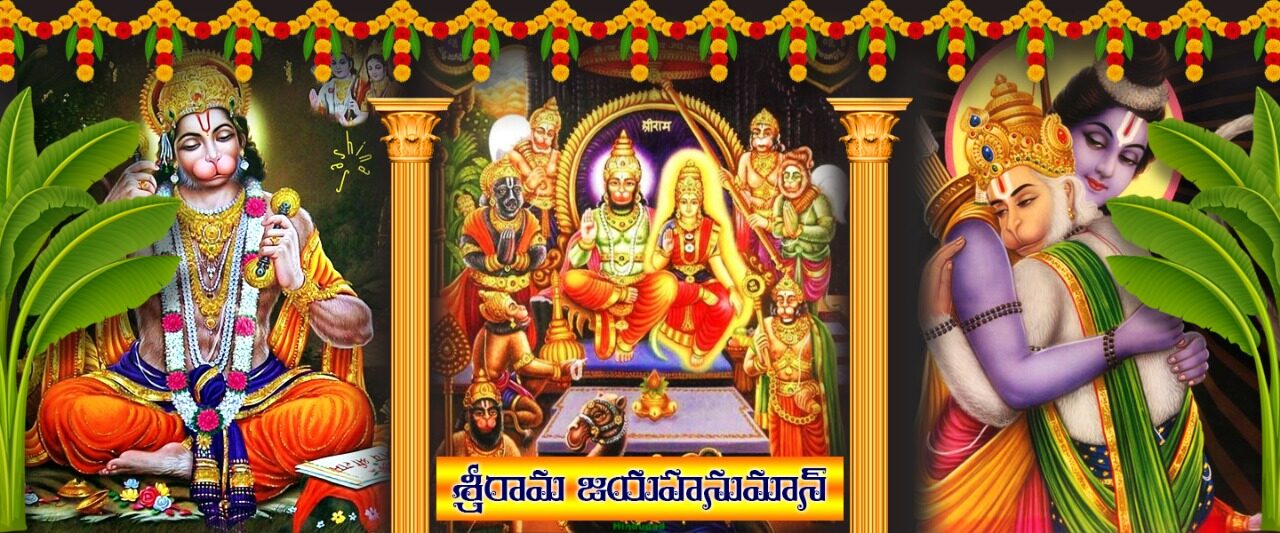


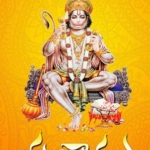
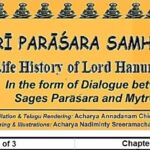
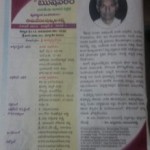
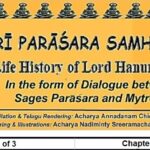
Be First to Comment